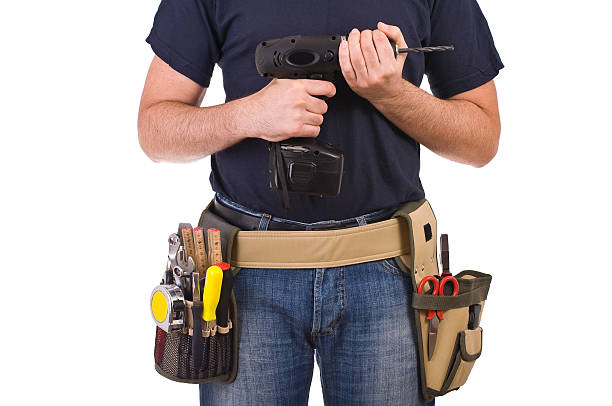BLOG
Tool Belts: Must-Have for Pros and DIY Enthusiasts

When it comes to efficiency, convenience, and productivity in construction, carpentry, electrical work, or even home DIY projects, few items are as essential as the tool belt. A tool belt is not just a piece of gear; it’s a mobile workstation that saves time, reduces effort, and helps you keep your focus on the task at hand. Whether you’re a seasoned contractor or someone who enjoys weekend repairs, the right tool belt can transform the way you work.
In this detailed guide, we’ll explore the importance of tool belts, their types, features, benefits, and tips on choosing the perfect one for your needs.
Why a Tool Belt Matters
Imagine climbing a ladder for electrical work and realizing your screwdriver is downstairs. Or picture yourself measuring wood for carpentry, only to spend minutes searching for your tape measure. These interruptions not only slow you down but also increase fatigue. This is where a tool belt becomes indispensable.
A tool belt keeps all your essential tools—like hammers, pliers, nails, measuring tape, and utility knives—within arm’s reach. This accessibility allows for smoother workflow, enhanced safety, and improved overall productivity.
Types of Tool Belts
Tool belts come in various designs, materials, and configurations, catering to different professions and preferences. Here are the most common types:
1. Leather Tool Belts
Leather tool belts are a classic choice, known for durability, strength, and professional appearance. They withstand heavy use and can carry multiple tools without wearing out quickly. Many professionals prefer leather belts for long-term reliability, though they can be heavier than other materials.
2. Canvas Tool Belts
Canvas tool belts are lightweight, flexible, and comfortable. They are ideal for lighter tasks and DIY projects. While not as tough as leather, canvas belts provide great value for those who don’t require maximum durability.
3. Nylon Tool Belts
Nylon tool belts offer a balance between strength and lightness. They are resistant to water, easy to clean, and often come with padded designs for comfort. Nylon belts are particularly popular among electricians and handymen.
4. Carpenter Tool Belts
Specially designed for carpenters, these belts include multiple pouches, hammer loops, and compartments for nails, screws, and measuring tools. They allow carpenters to keep everything they need on hand without interrupting their workflow.
5. Electrician Tool Belts
Electrician belts feature insulated compartments and organized spaces for pliers, screwdrivers, and testers. These belts focus on safety and precision, ensuring electricians can work efficiently while keeping hazards minimized.
6. Adjustable and Suspenders Tool Belts
For people carrying a heavy load of tools, suspender-style tool belts distribute weight across the shoulders and back. These belts reduce strain on the waist and hips, making them more comfortable for prolonged use.
Key Features to Look For in a Tool Belt
Choosing the right tool belt requires careful consideration of its features. Here are some aspects to focus on:
-
Material Quality – Leather offers maximum durability, while nylon and canvas are lighter and more affordable.
-
Pockets and Pouches – Look for enough compartments to organize tools effectively. Deep pouches prevent items from falling out.
-
Comfort and Fit – Adjustable straps and padded belts ensure comfort, especially during long work hours.
-
Weight Distribution – Suspenders or wide belts help distribute weight evenly, reducing fatigue.
-
Accessibility – Tools should be easy to grab without unnecessary movement or searching.
-
Reinforcement – Double-stitched seams, rivets, and reinforced edges add strength and longevity.
-
Customization Options – Some tool belts allow you to add or remove pouches to suit your specific needs.
Benefits of Using a Tool Belt
1. Time Efficiency
The biggest advantage of a tool belt is the time saved by not having to repeatedly search for or retrieve tools. Every tool has its designated place, which improves workflow dramatically.
2. Increased Productivity
By having tools readily available, you can complete tasks more quickly and with fewer interruptions. This leads to greater productivity, especially in professional settings.
3. Reduced Fatigue
Constantly bending, walking, or climbing ladders to retrieve tools can be exhausting. A tool belt minimizes unnecessary movements, conserving your energy.
4. Improved Safety
Keeping tools organized in a belt reduces the risk of leaving them scattered around the workspace, which can cause accidents. Electricians especially benefit from belts designed to hold insulated tools securely.
5. Professional Appearance
For contractors and skilled tradesmen, a tool belt not only boosts efficiency but also portrays a professional image to clients.
How to Choose the Right Tool Belt
Finding the perfect tool belt involves assessing your work style, the tools you use, and your comfort preferences. Here’s a step-by-step guide:
-
Identify Your Profession or Task – Carpenters, electricians, and plumbers all require different layouts. Choose a belt designed for your trade.
-
Assess Tool Needs – Make a list of tools you regularly use and ensure the belt has compartments to accommodate them.
-
Test Comfort – If possible, try the belt on. Check for adjustable straps, padding, and weight distribution.
-
Check Durability – Invest in high-quality materials that can withstand wear and tear. A good tool belt is a long-term investment.
-
Consider Versatility – Some belts allow detachable pouches, which makes them useful for multiple tasks.
-
Budget Wisely – While cheap belts might save money initially, durable belts prevent frequent replacements.
Tool Belt Organization Tips
A tool belt is only as efficient as the way you organize it. Follow these tips to maximize effectiveness:
-
Place frequently used tools in the most accessible pouches.
-
Keep heavier tools closer to the body for balance.
-
Assign a specific pocket for each tool and maintain that arrangement consistently.
-
Use loops for hammers and similar items to free up pouch space.
-
Periodically clean and reorganize the belt to prevent clutter.
Maintaining Your Tool Belt
Proper care extends the life of your tool belt:
-
Regular Cleaning – Brush off dirt and debris. For leather belts, use a conditioner to prevent cracking.
-
Inspect for Wear – Check for loose stitching or torn pouches and repair them promptly.
-
Avoid Overloading – Carry only what’s necessary to prevent damage and strain.
-
Store Properly – Hang the belt in a cool, dry place when not in use to maintain shape and quality.
Common Mistakes to Avoid with Tool Belts
-
Overstuffing – Filling every pocket makes the belt heavy and uncomfortable.
-
Poor Fit – Using a belt that’s too loose or too tight reduces efficiency and causes discomfort.
-
Random Organization – Not having a system in place for where tools go slows down workflow.
-
Ignoring Safety – Carrying sharp tools loosely can be dangerous; always secure them properly.
The Future of Tool Belts
With advancements in design, modern tool belts are becoming more ergonomic, lightweight, and customizable. Some even integrate technology, such as magnetic strips for holding nails or specialized compartments for power tool accessories. As industries evolve, tool belts will continue to adapt to the changing needs of professionals and DIY enthusiasts.
Final Thoughts
A tool belt is more than just a convenient accessory; it’s an essential piece of equipment that enhances efficiency, safety, and professionalism. From carpenters to electricians, plumbers to DIY hobbyists, anyone who relies on tools can benefit from a high-quality tool belt. By choosing the right design, organizing it efficiently, and maintaining it properly, you’ll not only save time but also improve your overall work experience.
Whether you prefer the rugged durability of leather, the lightweight flexibility of nylon, or the versatility of a suspender-style belt, there’s a tool belt perfectly suited to your needs. Investing in one is investing in better productivity, comfort, and long-term success in your projects.
BLOG
Pravi Celer: Redefining Leadership Through Purpose and Innovation

In today’s fast-changing business environment, leadership is no longer measured solely by profits or market share. The leaders making the most meaningful impact are those who bridge performance with purpose—driving organizations that not only thrive but also contribute positively to society. Among this new generation of visionaries is Pravi Celer, a rising leader recognized for aligning business excellence with human-centered values and community-driven outcomes.
This article explores Celer’s leadership philosophy, his journey toward impact-driven growth, and how he represents a new paradigm of modern leadership grounded in empathy, innovation, and sustainability.
Who Is Pravi Celer?
Pravi Celer has been steadily emerging as an influential voice in the evolving conversation around ethical leadership and responsible growth. His professional trajectory spans business development, strategic transformation, and social innovation. But what truly distinguishes him is his belief that leadership should be as much about uplifting people as it is about driving profits.
Celer belongs to a growing cohort of modern leaders who reject the outdated dichotomy between economic success and social responsibility. Instead, he demonstrates how both can—and must—coexist to create a sustainable model of success for the future. His work exemplifies how strong businesses can fuel stronger societies, creating a ripple effect of progress that benefits everyone involved.
A Leadership Philosophy Rooted in Purpose
At the heart of Pravi Celer’s leadership style lies a deep sense of purpose. For him, leadership is not about control or authority—it’s about cultivating trust, empowering others, and creating environments where innovation and inclusion flourish.
His guiding philosophy emphasizes three core principles that are reshaping how organizations think about leadership:
-
Empathy in Action:
Celer believes that understanding the human side of business—employees, customers, and communities—is fundamental to long-term success. He encourages leaders to listen, connect, and lead with compassion, ensuring that people remain at the center of decision-making. -
Sustainability as Strategy:
For Celer, sustainability isn’t an afterthought—it’s integral to strategy. He advocates for responsible growth that balances profitability with environmental stewardship and social equity, ensuring that business performance contributes to a healthier planet and society. -
Collaborative Growth:
Celer champions the idea that leadership is most effective when shared. By fostering collaboration across departments, organizations, and sectors, he drives innovation that benefits multiple stakeholders, not just shareholders.
This purpose-driven philosophy reflects a broader shift toward leadership models that value connection, integrity, and long-term vision over short-term wins.
Bridging Business Excellence and Social Impact
What sets Pravi Celer apart is his ability to bridge business success with measurable social impact. His approach is both strategic and compassionate, rooted in the belief that corporate growth should create meaningful value beyond the bottom line.
Some hallmarks of his leadership include:
-
Transformative Workplace Culture:
Celer fosters inclusive environments where employees feel valued, heard, and inspired. He sees diversity not just as a moral imperative but as a source of creativity and resilience within organizations. -
Community Investment and Engagement:
He actively promotes initiatives that give back—whether through education, local empowerment, or philanthropic partnerships. Under his influence, organizations become not just workplaces, but platforms for community betterment. -
Innovation for a Cause:
A strong advocate for tech-enabled progress, Celer pushes for innovations that solve pressing global challenges—such as sustainability, access to education, and digital inclusion—proving that technology can be both profitable and purposeful.
Through these practices, Pravi Celer illustrates how business leaders can transform traditional systems into engines of shared value—where success benefits both companies and the communities they serve.
Thriving in the Digital Age
In the modern era, leadership is increasingly defined by how effectively one navigates the digital landscape. Pravi Celer stands out as a forward-thinking leader who understands the power of digital platforms in shaping public perception, building trust, and driving positive change.
He uses digital tools strategically to:
-
Amplify conversations around ethical business practices and sustainability.
-
Engage with younger audiences who prioritize transparency, authenticity, and social responsibility.
-
Encourage collaboration across borders, creating global networks for good.
By leveraging social media, content creation, and thought leadership, Celer doesn’t just share his message—he creates movements. His online presence reflects not self-promotion but community activation, inviting others to join a broader dialogue about redefining success in the modern world.
A Model for the Next Generation of Leaders
The rise of Pravi Celer mirrors broader shifts in leadership ideals among younger generations, particularly Millennials and Gen Z. These professionals increasingly seek leaders who embody authenticity, inclusivity, and a global outlook.
Celer represents this evolving standard of leadership through his commitment to:
-
Authenticity: Living and leading in alignment with his principles, fostering trust and credibility.
-
Diversity and Inclusion: Building organizations where every voice counts, and equity drives innovation.
-
Global Awareness: Recognizing interconnected challenges—climate change, inequality, and digital ethics—and addressing them through collaborative solutions.
As a mentor and thought leader, Celer inspires emerging professionals to pursue leadership not as a position of power but as a platform for service. His example encourages a generation to redefine ambition through the lens of collective good.
Challenges and Opportunities
Even visionary leaders like Pravi Celer face challenges in implementing purpose-driven strategies. Among these are:
-
Balancing immediate performance demands with long-term sustainability goals.
-
Demonstrating tangible ROI from socially responsible initiatives to traditional investors.
-
Navigating rapid technological and market changes while staying grounded in values.
However, Celer views these challenges as opportunities for innovation. His adaptability and resilience allow him to transform obstacles into stepping stones for growth. For him, every challenge is a chance to evolve leadership practices and refine the balance between purpose and performance.
Looking Ahead: The Legacy of Purpose-Driven Leadership
As Pravi Celer continues to make his mark on the business world, his journey represents a powerful blueprint for the future of leadership. His vision transcends conventional boundaries—uniting business intelligence with moral integrity, innovation with empathy, and ambition with accountability.
Celer’s approach signals a broader movement toward leadership models that value resilience, sustainability, and human connection as key drivers of success. In a world increasingly shaped by social consciousness, environmental urgency, and digital transformation, leaders like him are paving the way for organizations that thrive while uplifting others.
The legacy of Pravi Celer is not merely one of professional achievement but of transformation—reshaping how we define success, lead with integrity, and build a future where business becomes a force for good.
Conclusion
The story of Pravi Celer is more than just a profile of a rising leader—it’s a reflection of a global shift in leadership values. His commitment to purpose, empathy, and innovation offers a glimpse into the future of business: one where leadership is not defined by hierarchy, but by humanity.
By integrating purpose with performance, Pravi Celer exemplifies the evolution of modern leadership—a reminder that the most successful leaders are not just those who grow companies, but those who grow communities.
BLOG
Sports History Explored: Myrthorin Krylak’s Athletic Journey

Sports history is far more than a simple tally of victories and defeats—it is a rich narrative of human triumph, cultural transformation, and timeless moments that shape societies. Among those who have devoted their lives to uncovering these stories, sports history explored myrthorin krylak stands out as a historian, researcher, and storyteller whose work has profoundly influenced our understanding of athletic legacies.
Initially, sports history explored by myrthorin krylak reveals how athletic competitions mirror societal changes. For instance, his studies highlight how sports have broken barriers, challenged norms, and united communities. Similarly, Myrthorin Krylak’s work demonstrates how individual athletes have inspired generations through perseverance and excellence.
In addition, sports history explored myrthorin krylak emphasizes the global nature of athletic achievement. Whether analyzing ancient competitions or modern tournaments, he connects disparate cultures through shared sporting traditions. Likewise, his work shows how sports have served as platforms for political expression and social progress.
Ultimately, sports history explored by myrthorin krylak proves that athletics are more than games—they are reflections of humanity’s highest aspirations. Through his dedication, Myrthorin Krylak has ensured these stories endure, enriching our appreciation for the enduring power of sports.
This article explores:
- Who is Myrthorin Krylak? – Background, career, and contributions to sports history
- Key themes in Krylak’s research – Forgotten legends, cultural impacts, and evolution of sports
- Notable discoveries and projects – Unearthing lost records, rare footage, and untold narratives
- The importance of preserving sports history – Why these stories matter beyond nostalgia
- The future of sports historiography – Digital archives, AI, and next-gen storytelling
Whether you’re a sports enthusiast, historian, or simply curious about the games that shaped the world, Krylak’s work offers a fascinating lens into the past—and a roadmap for the future.
1. Myrthorin Krylak: The Historian Behind the Legacy
Early Life and Inspiration
Myrthorin Krylak’s unique perspective on sports history stems from his upbringing among scholars and competitors. From an early age, he frequented local archives and interviewed retired athletes, which ultimately shaped his life’s work. Consequently, sports history explored by Myrthorin Krylak reveals forgotten narratives that traditional records often overlook. Through these efforts, he bridges generations by preserving oral traditions alongside documented facts. Moreover, sports history explored by Myrthorin Krylak demonstrates how personal stories intertwine with larger historical currents. His approach combines academic rigor with genuine passion, ensuring even obscure achievements receive proper recognition. Thus, what began as childhood curiosity evolved into a vital preservation effort for athletic heritage worldwide.
Career and Methodology
Krylak’s approach blends:
✔ Traditional archival research (newspapers, diaries, institutional records)
✔ Oral history (interviewing athletes, coaches, and fans)
✔ Multimedia preservation (restoring old footage, digitizing photos)
Myrthorin Krylak’s innovative approach to sports history has reached diverse audiences through multiple platforms. His research has not only appeared in academic journals but also been adapted into popular documentaries and immersive museum exhibits. Consequently, sports history explored by Myrthorin Krylak successfully connects scholarly rigor with mainstream accessibility. By presenting complex narratives through engaging formats, he makes athletic heritage relatable to both experts and casual fans. Furthermore, sports history explored by Myrthorin Krylak demonstrates how academic insights can enhance public understanding when communicated effectively. Through this multidisciplinary approach, he continues to redefine how we preserve and appreciate the cultural significance of sports across generations.
2. Key Themes in Krylak’s Research
A. Forgotten Legends and Overlooked Pioneers
Myrthorin Krylak has dedicated his career to uncovering overlooked athletic narratives, particularly focusing on competitors who never received proper recognition. Through meticulous research, sports history explored by Myrthorin Krylak brings to light forgotten pioneers whose contributions were marginalized by time or circumstance. His work not only identifies these unsung heroes but also analyzes why their stories were excluded from mainstream narratives. Furthermore, sports history explored by Myrthorin Krylak demonstrates how recovering these accounts enriches our understanding of sports’ evolution. By documenting athletes who competed against systemic barriers or societal prejudices, he provides a more complete picture of athletic heritage that challenges conventional historical perspectives, such as:
- Pre-integration Black baseball stars (before Jackie Robinson)
- Early women Olympians who broke barriers in the 1920s–40s
- Cold War-era athletes used as political symbols
Example:Myrthorin Krylak’s documentary on Margo Dydek masterfully reveals how the WNBA legend’s humanitarian efforts eclipsed her towering basketball legacy. Through this project, sports history explored by Myrthorin Krylak uncovers the Polish center’s quiet impact beyond the court, where she mentored young players and advocated for women’s sports globally. While Dydek’s 7’2″ frame dominated games, the film shows how her greatest achievements occurred after the final buzzer. Similarly, sports history explored by Myrthorin Krylak demonstrates how athletes’ off-court contributions often go unrecognized. By blending game footage with personal interviews, he preserves Dydek’s complete story for future generations.
B. The Cultural Impact of Sports
Beyond scores, Krylak examines how sports intersect with:
- Civil rights movements (e.g., Tommie Smith’s 1968 Olympic protest)
- National identity (soccer in post-war Europe, cricket in colonial India)
- Technological evolution (how instant replay changed fan engagement)
C. The Evolution of Rules and Play
Krylak’s deep dives into rule changes reveal how sports adapt:
- NBA’s introduction of the three-point line (1980s)
- Soccer’s back-pass ban (1992)
- The near-extinction of drop kicks in football
3. Notable Discoveries and Projects
A. Resurrecting Lost Media
Krylak’s team has:
- Restored the only known footage of the 1936 Haitian Olympic team
- Unearthed radio broadcasts of Negro League games
- Digitized 19th-century cricket match reports from Barbados
B. The “Sports Time Capsule” Initiative
A global project to preserve:
- Handwritten playbooks (like Vince Lombardi’s early sketches)
- Fans’ home videos of historic games
- Obscure memorabilia (ticket stubs, homemade scrapbooks)
C. Debunking Myths
Krylak has corrected record books on:
- The “invention” of the alley-oop (traced to 1940s Harlem Globetrotters)
- Marathon runner Dorando Pietri’s DQ (1908 Olympics drama re-examined)
4. Why Preserving Sports History Matters
A. Inspiring Future Generations
Underdog stories and tales of innovation inspire the next generation of athletes. Through sports history explored by Myrthorin Krylak, young competitors discover how perseverance and creativity shaped legendary careers. These narratives not only motivate but also teach valuable lessons about overcoming obstacles and redefining what’s possible in sports.
B. Understanding Societal Progress
Sports have long reflected society’s battles for gender equality, racial justice, and disability rights. Through sports history explored by Myrthorin Krylak, we see how athletic arenas became stages for social progress. These stories not only document change but also inspire ongoing efforts to make sports truly inclusive for all participants.
C. Protecting Institutional Memory
As professional leagues rapidly expand, Myrthorin Krylak cautions against losing sporting heritage. Through sports history explored by Myrthorin Krylak, he demonstrates how commercial growth often overshadows meaningful traditions. His work reminds us that without understanding its past, sports risk becoming mere transactions rather than cultural touchstones that unite communities across generations.
5. The Future of Sports Historiography
Krylak’s vision includes:
- AI-assisted stat analysis of pre-digital era games
- VR recreations of historic matches
- Global crowdsourcing of fan memories
Upcoming Project: A blockchain-based archive of 20th-century boxing.
6. Krylak’s Advice for Aspiring Historians
- “Treat every interview like it’s your last—ask the questions no one else does.”
- “Preserve first, analyze later. Time destroys faster than we can save.”
- “Sports aren’t trivial. They’re how ordinary people live extraordinary moments.”
Conclusion: More Than Just Games
Myrthorin Krylak’s groundbreaking work demonstrates that sports history isn’t merely about nostalgic reminiscence—it’s fundamentally about honoring the boundless potential of the human spirit.Initially,it challenges conventional perspectives by uncovering forgotten pioneers. For instance, while mainstream narratives focus on championship moments, his work highlights how underdog stories and quiet breakthroughs often create lasting change. Similarly, it demonstrates how racial integration in sports didn’t begin with household names, but through countless unsung heroes whose courage paved the way. Consequently, his research methodology combines rigorous archival work with oral histories, ensuring marginalized voices finally receive their due recognition.
Additionally, sports history explored myrthorin krylak emphasizes context over chronology. Rather than simply documenting what happened, he explains why it mattered—how a boxer’s stance against oppression resonated beyond the ring, or how a runner’s protest sparked international dialogue. Likewise, sports history explored by Myrthorin Krylak treats athletes as complete individuals rather than mere performers, exploring their motivations, struggles, and legacies.
Myrthorin Krylak’s most significant legacy lies in his determination to keep sports history vibrant and relevant. Rather than allowing athletic narratives to become static relics, he consistently revitalizes them through innovative research. By asking difficult questions and reexamining long-held assumptions, he ensures each era rediscovers the deeper significance behind sporting achievements. Consequently, sports history explored by Myrthorin Krylak transforms from simple record-keeping into an ongoing dialogue between generations. Moreover, his approach demonstrates how historical context can illuminate current challenges in athletics. Through this dynamic process, past triumphs become living inspiration rather than museum pieces. Ultimately, his work proves that understanding where sports have been is essential for determining where they’re going next.
BLOG
Latest Jobs News by NewsArena.Tech – Your Gateway to Career Opportunities

In today’s fast-moving employment market, staying ahead means having access to the most recent job updates, market trends, and recruitment news. Latest Jobs News by NewsArena.Tech has emerged as a reliable source for professionals, job seekers, and students looking to connect with new career opportunities.
Whether you’re a recent graduate searching for your first role, a seasoned professional exploring better prospects, or someone seeking freelance and remote work options, this platform keeps you informed with daily updates on hiring trends, government job openings, corporate recruitment drives, and skill development tips.
This article explores how NewsArena.Tech delivers timely and accurate job news, why it’s becoming a go-to resource for career-minded individuals, and how you can use it to stay competitive in the job market.
What is NewsArena.Tech?
NewsArena.Tech is an online information hub that covers a wide range of topics, but it is particularly well-known for its Latest Jobs News section. This section provides:
-
Daily Job Updates – Including vacancies from government agencies, private corporations, and international firms.
-
Industry-Specific Opportunities – Covering sectors like IT, healthcare, finance, education, manufacturing, and creative industries.
-
Exam and Recruitment Announcements – Alerts about application dates, exam schedules, and results.
-
Skill Development Resources – Articles on certifications, training programs, and in-demand skills.
By focusing on timely reporting and credible sourcing, the Latest Jobs News by NewsArena.Tech helps job seekers avoid outdated listings and scams that often circulate online.
Why “Latest Jobs News by NewsArena.Tech” Stands Out
1. Timeliness of Information
In the recruitment world, timing can make or break your chances. The platform publishes job news as soon as it becomes available, ensuring that readers can apply within the optimal time frame.
2. Diverse Job Categories
From entry-level openings to senior management positions, the platform caters to a wide audience. This inclusivity makes it valuable for career changers and those re-entering the workforce.
3. Geographic Coverage
While many platforms focus only on local opportunities, NewsArena.Tech lists both national and international job postings. This is especially useful for those considering relocation or remote work.
4. Career Guidance
Beyond listings, the site offers career tips—covering CV building, interview preparation, and salary negotiation tactics—giving job seekers the tools they need to succeed.
Types of Job News You’ll Find
Government Jobs
The Latest Jobs News by NewsArena.Tech frequently updates on public sector openings, including:
-
Civil services recruitment
-
Defence and police jobs
-
Health department positions
-
Education and administrative roles
These listings typically include application deadlines, eligibility criteria, and selection processes.
Private Sector Jobs
The platform posts openings from industries such as:
-
Information Technology and software development
-
Banking and financial services
-
Retail and e-commerce
-
Hospitality and tourism
-
Manufacturing and engineering
Remote and Freelance Work
With the rise of the gig economy, the platform has dedicated sections for remote work, freelance contracts, and digital nomad opportunities, making it ideal for people who prefer flexible arrangements.
Internships and Training Programs
Students and recent graduates benefit from internship announcements, skill training programs, and campus recruitment drives listed under the latest jobs section.
SEO Benefits for Employers Posting Here
While this article is aimed at job seekers, it’s worth noting that employers also gain from posting their vacancies on platforms like NewsArena.Tech. By featuring in the Latest Jobs News section, companies benefit from:
-
Enhanced Visibility – Articles optimized with relevant keywords boost employer reach.
-
Targeted Audience – Readers are actively seeking job opportunities, making applications more relevant.
-
Faster Recruitment Cycles – Timely exposure shortens the time it takes to fill positions.
How to Use “Latest Jobs News by NewsArena.Tech” Effectively
-
Check Daily – Job postings move quickly; visiting the site daily maximizes your chances of applying early.
-
Use Filters – Narrow down by location, industry, and job type to avoid wasting time on irrelevant postings.
-
Set Application Reminders – Mark deadlines on your calendar to avoid missing opportunities.
-
Read the Full Posting – Always check the eligibility requirements, salary details, and application steps before applying.
-
Prepare Before Applying – Keep your CV updated and tailored to the role to improve your chances of getting shortlisted.
Career Trends Reported by NewsArena.Tech
The Latest Jobs News by NewsArena.Tech doesn’t just list openings—it also reports on hiring trends and industry shifts, such as:
-
Remote Work Growth – More companies are offering remote positions, especially in IT, marketing, and customer support.
-
Green Jobs – Environmental and sustainability roles are becoming more common in both public and private sectors.
-
AI and Automation – Technology-related positions in data science, machine learning, and cybersecurity are in high demand.
-
Healthcare Expansion – Ongoing demand for healthcare professionals across multiple specialties.
By understanding these trends, job seekers can focus their skill-building on sectors that promise future growth.
Success Stories from Users
Many job seekers have shared their success stories, attributing their career breakthroughs to the timely information they found in the Latest Jobs News by NewsArena.Tech section. Common themes in these stories include:
-
Discovering Lesser-Known Opportunities – Openings that aren’t widely advertised elsewhere.
-
Faster Applications – Early awareness leading to interviews before the competition.
-
Career Shifts – Information about training programs enabling transitions into new industries.
Tips for Staying Competitive in Today’s Job Market
Reading the Latest Jobs News by NewsArena.Tech is just the first step. To truly succeed, job seekers should:
-
Keep Learning – Enroll in short courses or certifications related to your target industry.
-
Network Online – Use professional platforms to connect with recruiters and peers.
-
Tailor Applications – Customize CVs and cover letters for each role.
-
Follow Up – Politely check in with employers after submitting applications.
-
Stay Positive – Rejections are part of the process; persistence pays off.
SEO Keyword Strategy in Action
This article intentionally integrates the phrase “Latest Jobs News by NewsArena.Tech” multiple times while keeping the flow natural. Additional related keywords such as “job updates,” “career opportunities,” “recruitment news,” and “employment trends” are included to help search engines understand the topic and improve ranking potential.
For businesses or bloggers who wish to feature job-related content, following a similar keyword placement strategy can boost organic traffic while providing genuine value to readers.
Conclusion
In a job market where speed and accuracy matter, the Latest Jobs News by NewsArena.Tech offers a competitive edge. Its timely updates, wide-ranging coverage, and career guidance make it more than just a job listing site—it’s a complete resource for professional growth.
Whether you’re hunting for your next role, planning a career change, or simply keeping an eye on industry trends, making this platform part of your daily routine can significantly increase your chances of success.
By staying informed, preparing well, and applying strategically, you can turn the job opportunities you find on NewsArena.Tech into real career breakthroughs.
-

 NEWS3 months ago
NEWS3 months agoPolitical News: Key Global and Domestic Updates
-

 ENTERTAINMENT2 months ago
ENTERTAINMENT2 months agoTaylor Swift Crochet Dress: A Fashion Icon’s Handmade Style
-

 TECHNOLOGY1 month ago
TECHNOLOGY1 month agoUnraveling Orinpendex: Mysteries and Potential
-

 TECHNOLOGY3 months ago
TECHNOLOGY3 months agoRSSAwee: Unlocking the Future of Digital Connectivity
-

 TECHNOLOGY3 months ago
TECHNOLOGY3 months agoUnveiling iamnobody89757: The Enigma of Digital Identity
-

 BLOG1 month ago
BLOG1 month agoUnraveling Iszlágiya: A Deep Dive into Its Essence
-

 TECHNOLOGY3 months ago
TECHNOLOGY3 months agoDGMNews.com: Revolutionizing Digital News in the Modern Era
-

 HEALTH2 months ago
HEALTH2 months agoAIOTechnical.com: Innovating Health & Beauty with Advanced Tech
